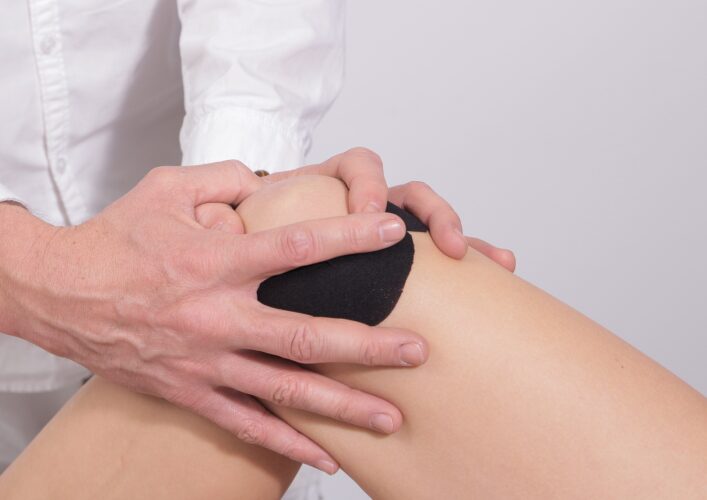Dans les douleurs antérieures du genou, le syndrome douloureux fémoro-patellaire (SDFP) est l’une des causes les plus fréquentes surtout chez les adolescents et en particulier les adolescentes, où l’on note une forte composante émotionnelle.

Le diagnostic du trouble fémoro-patellaire
Ce syndrome est multifactoriel et demande une analyse complète du membre inférieur ainsi qu’une étude dynamique de la marche et de la course. L’étude de la posture nous donnera de précieuses informations. L’anamnèse et l’examen clinique permettent de faire le diagnostic, sachant que très souvent l’imagerie radiologique est normale.
La prise en charge
C’est probablement la pathologie dont le traitement conservateur est le plus indéniablement dédié à la kinésithérapie.
Cependant, une revue de littérature des nombreuses études cliniques des traitements conservateurs ne détermine pas de traitement type.
Néanmoins, il apparait pour Brosseau et col. (2001) que les ultrasons n’ont aucun effet bénéfique sur le SDFP, et d’autres auteurs montrent plus récemment l’effet bénéfique de l’exercice physique en chaîne cinétique ouverte ou fermée, avec une préférence pour le travail musculaire de type isométrique.
L’électro neuro stimulation a eu ses adeptes mais elle est finalement peu ou mal utilisée d’autant plus que si les muscles stimulés par électro-induction ne sont pas réafférentés, l’augmentation de force n’est pas ou peu fonctionnelle ou nécessite une réathlétisation souvent peu compatible avec un SDFP.
La prise en charge avec la reprogrammation neuromotrice Allyane
Pourquoi utiliser cette méthode ?
C’est justement dans ce cadre que se pose l’intérêt d’une reprogrammation neuromotrice (RNM). Celle-ci est particulièrement effective dans les SDFP avec Valgus dynamique, ce qui contribue à augmenter la latéralisation de la rotule.
L’un des chefs clef du quadriceps est le vaste médial oblique (VMO). Pourquoi ? Car ses fibres horizontales créent un vecteur de force médiale sur la patella, surtout dans les derniers degrés d’extension du genou.
À haut pourcentage de fibres posturales, le VMO est particulièrement affecté par un flessum antalgique ou encore par l’inactivité dans son secteur articulaire. De par son innervation par le nerf saphène, différente des autres chefs du quadriceps, il tend à se comporter comme un muscle dysfonctionnel au sein d’un quadriceps qui présente souvent lors des tests, une force concentrique ou excentrique normale, en particulier chez le sportif.
Un VMO dysfonctionnel dans un premier temps, puis désafférenté dans un deuxième temps – précédant une amyotrophie spécifique de façon plus tardive – va induire un retard de contraction par rapport au quadriceps et en particulier du vaste latéral. Ceci entraînera une latéralisation précoce de la patella et à court terme un SDFP surtout si d’autres facteurs aggravants comme un valgus dynamique, une bandelette ilio-tibiale rétractée ou un pied plat sont présents.
Comment agit la méthode Allyane ?
-
Prise de conscience du geste
Lors d’une séance Allyane, le patient devra, dans un premier temps, prendre conscience de la contraction élective de son VMO.
Classiquement, on demande au patient de conjuguer l’extension résistée du genou à une adduction de hanche en écrasant un coussin. En RNM, il est souhaitable de proposer au patient allongé sur une table de massage, une élévation résistée de la jambe en extension jusqu’à 45º, pied en légère rotation externe. Cela lui permet une prise de conscience plus élective de son VMO sans être perturbé au niveau sensoriel par la contraction des adducteurs.
-
Imagerie mentale
Après plusieurs contractions du côté sain, il doit non seulement produire l’image mentale de la contraction de son VMO, mais également celle de la qualité du recrutement musculaire dès le début de l’élévation du membre inférieur.
-
Écoute de sons de basse fréquence
Une fois cette sensation acquise, le patient reste allongé avec le casque audio de l’Alphabox générant des sons pulsés de basse fréquence, ce qui va lui permettre de passer en mode alpha d’activité cérébrale tout en hyper-activant ses aires motrices.
-
Phase d’effacement
Il va tout d’abord déprogrammer son SDFP. Il va reproduire l’image motrice des sensations proprioceptives de son genou douloureux avec un VMO peu réactif, un léger temps de latence lors de sa mise en tension. Puis, accompagné par le thérapeute, il va poursuivre ce travail d’imagerie mentale spécifique en effaçant ce geste et les zones corporelles considérées. A ce moment-là, l’opérateur envoie un son référent choisi par le patient. C’est la phase de déprogrammation ou d’effacement.
-
Reprogrammation
Puis, il reprogramme en produisant l’image mentale des sensations proprioceptives acquises sur son VMO sain, lors d’une extension explosive virtuelle du genou pathologique. Lorsqu’il a visualisé correctement cette sensation, le praticien envoie de nouveau le son référent. C’est la phase de reprogrammation.
-
Analyse de fin de séance
L’opérateur teste ensuite en réel le VMO affecté en sollicitant une extension résistée de la jambe à 45º et la réponse est nettement améliorée, parfois même supérieure au côté sain. Ceci pourra être objectivé par une analyse dynamométrique appropriée.
On dispose alors d’un VMO réafférenté qui sera optimisé par une rééducation, une électro stimulation ou une réathlétisation qui auront à partir de ce moment une bien meilleure efficacité.
Et après ?
Il m’arrive souvent de proposer une deuxième séance Allyane de RNM à un mois pour corriger, lors du saut unipodal, le valgus dynamique s’il y a lieu.
